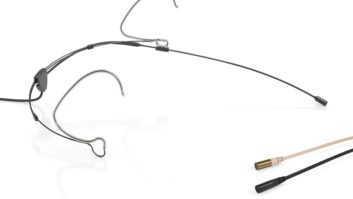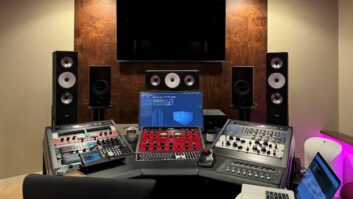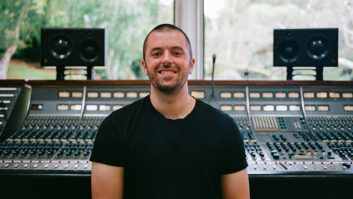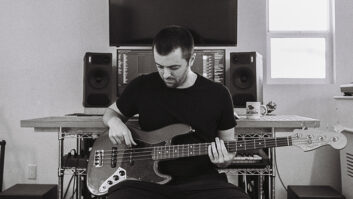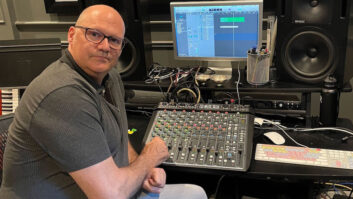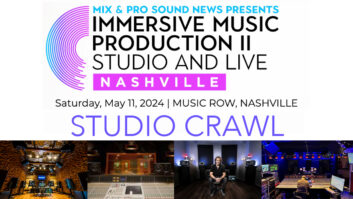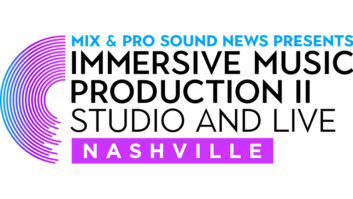
Spring Hill, TN—Early in his career, Rob Burrell had to decide between making records and making movies. Fast-forward a couple of decades and Burrell can now indulge his twin passions under one roof following an upgrade of his home studio to an 11.1.4 Dolby Atmos mix environment.
Not that Burrell was unable to mix both sound-to-picture and music projects during the intervening years. In fact, he said, he became the go-to guy in Nashville for 5.1 projects almost as soon as the technology allowed. “As soon as surround was possible on the Mackie Digital 8-Bus, I set up five speakers and went for it,” he said.
Having chosen to move to Nashville, which he and his wife felt was preferable to Los Angeles for the large family they planned to raise, Burrell thought he’d scotched any chances of getting his foot in the Hollywood door: “I was mad because I didn’t want to have to pick. I’ve always been a big fan of both—I grew up a musician and a lover of film and storytelling.”
He lost no time in establishing a reputation in Music City, working with the likes of Carrie Underwood, Little Big Town, Michael W. Smith and Michael McDonald. Since 1994, he’s engineered and/or mixed a host of Grammy-nominated and Grammy- and Dove Award-winning albums, bestsellers and Billboard 200-charting projects.
Burrell Builds for Dolby Atmos, April 21, 2020: Grammy-winning mix engineer Rob Burrell recently converted a space in his Nashville-area home studio into a Dolby Atmos mix room.
“By the late ’90s, I had an opportunity with some of the artists I was doing records with to do their live DVDs in 5.1,” he reports. That was soon followed by a slew of 5.1 remixes of studio recordings for Sony, he said.
As a result, Burrell’s studio has been able to handle 5.1 projects since the ’90s and 7.1 projects for the last several years. Because he had been keeping an eye on Dolby Atmos since its introduction in 2014, he was ready to pull the trigger on an upgrade when the tools became available for independent and home studios last year, he said. “As soon as Pro Tools and the Dolby renderer software happened, I knew it was going to be a piece of my future.”

Burrell installed eight JBL 306P MkII speakers for the surround and overhead zones around his room, which is 16 feet wide and 22 feet deep. A pair of ATC SCM50ASL speakers sit at left and right, while an ATC SCM20ASL supports the center channel. “The 20 is an incredible match to the 50s. The front speakers also use a dual Bag End subwoofer setup, so I have accurate, distortion-free extension,” he said.
Since the studio is in his basement, he couldn’t raise the 9-foot ceiling, but that’s plenty of height, he said. “Dolby has a lot of tolerances in their math for placement options, so I experimented for a long time before I chose my final angles and positions. I wanted translation to headphones in music, and the music mix experience and the film and TV experience to all work in my room.”
He did all the integration work himself, getting to grips with Dante networking and optimizing Pro Tools. “I’m a fanatic for workflow. It has always been crucial that whatever tech I choose can melt away once it’s set up and just become an extension to making music.”
Because mixing has been Burrell’s main occupation for the past 15 years, he has never needed to upgrade Pro Tools beyond HD Native, he said. Indeed, when he upgraded from his TDM rig, HDX had a reputation for “voice-stealing,” limiting the number of voices available when jumping between DSP and Native plug-ins, he said—a problem that was magnified when working with surround buses. “HD Native didn’t have that problem. I knew my 256 voices would be a true 256 voices.”
Then, having added Focusrite’s RedNet 16Line as the brain and backbone of his new Dolby Atmos setup, he reported, “One day I went into lab coat mode and ran it in Thunderbolt 3 mode. When I ditched the HD Native card and went to Thunderbolt 3, my CPU headroom had a 25 percent gain. Once I realized the stability of the system and the headroom, I sold the HD Native card.”
Valencia Builds Largest Educational RedNet Installation, May 14, 2018: Facilities for Valencia College’s Sound & Music Technology program are connected via Focusrite RedNet.
Now, he added, “I’m doing everything with a Focusrite interface via Thunderbolt 3 on a 2018 Mac mini. It’s Pro Tools Ultimate with the Atmos renderer on the same rig.”
Down the road he may need more horsepower for object-heavy Dolby Atmos mixes, but that will mean forking out for a costly new Mac Pro. “Until I see if the Atmos investments that I’ve made are going to pay off, I’m not going to make that decision—it’s another $10,000 or $11,000.” But for the moment, he said, “I freeze this track or commit that track to free up processing. It hasn’t become prohibitive yet.”
Burrell’s 40-channel D-Command surface served him well for years, but now he has four Avid S1s and a Dock, all fitted with Amazon Fire HD10s instead of iPads. He’s a tactile mixer, he said, after years of working on 80-fader SSL desks. “I really play a mix like an instrument. I love rolling up and down the console and tweaking balances.”
After years of having the Pro Tools monitor out of his field of view, he now has it center-front, but down low. “I ‘see’ the height and depth of my mix; I visualize it floating in the air. My brain has a finite amount of CPU power and my eyes will take more CPU power than my ears if I engage my eyes, and I don’t want my eyes stealing from my ears,” he explained.
Over the past 15 years, while Burrell has been focused on mixing, he has also seen some film projects roll in. “About 2005, indie filmmakers started contacting me. My first few clients, I said, ‘I don’t do film, but I’m a film junkie and I think I know what I’m doing with audio. If you want to learn with me, let’s do it together.’”
To date, he said, “I’ve done four full-length features and close to 30 or 40 shorts and documentaries, all indie and local.” A few have been released on Netflix, he said.
“So I’ve been able to have my cake and eat it, and be able to make records and make movies. I don’t have to choose!”
Focusrite • pro.focusrite.com
Rob Burrell • www.robburrellmix.com • Soundcloud link • Twitter @robburrellmix
Dolby • professional.dolby.com
